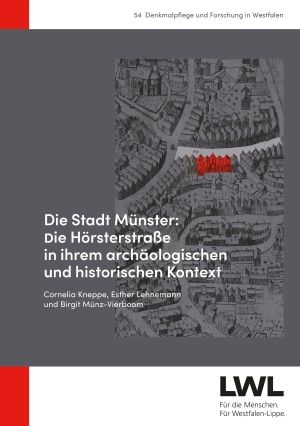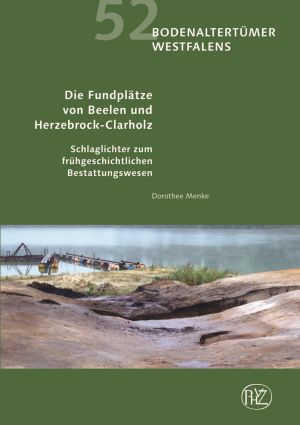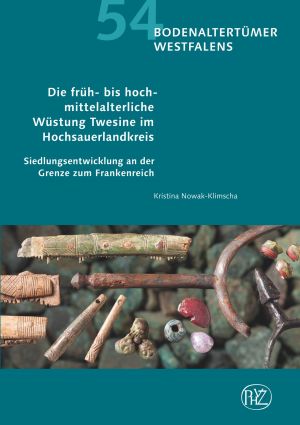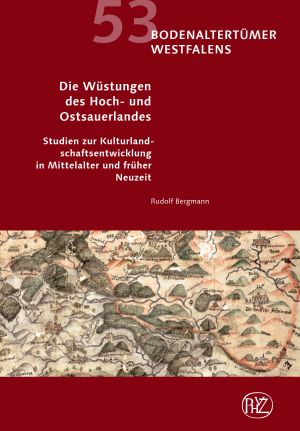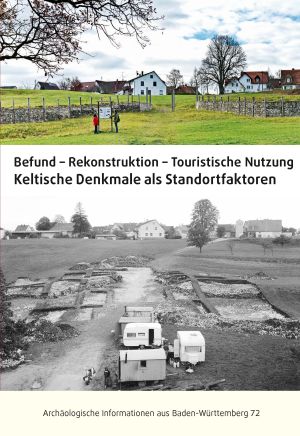Rind , Michael M.
Die Stadt Münster: Die Hörsterstraße in ihrem archäologischen und historischen Kontext
Die Hörsterstraße in Münster ist seit dem 12. Jahrhundert Teil der Stadtgeschichte. Abseits der großen Bürgerhäuser tritt hier ein Wohnquartier in den Fokus der archäologischen und historischen Untersuchungen, in dem Menschen aller gesellschaftlichen Schichten lebten.
Einschneidende Ereignisse wie die Zerstörung im Siebenjährigen Krieg und der folgende Wiederaufbau lassen sich auch im archäologischen Befund nachvollziehen. Aus einem komplexen Baubefund und breit gefächertem Fundmaterial analysieren Cornelia Kneppe, Esther Lehnemann und Birgit Münz-Vierboom Aspekte der materiellen Alltagskultur in der Hörsterstraße 40–45 vom Mittelalter bis in die jüngste Vergangenheit.
Die Fundplätze von Beelen und Herzebrock-Clarholz: Schlaglichter zum frühgeschichtlichen Bestattungswesen
Der völkerwanderungszeitliche Scheiterhaufenplatz in Herzebrock-Clarholz ist auch überregional eine echte archäologische Rarität. Außerdem wurden hier 22 Gräber aus dem 4. und 5. Jahrhundert untersucht. Für die Hinterbliebenen war anscheinend die Bestattungszeremonie selbst von zentraler Bedeutung, denn ein erheblicher Teil der Beigaben und der Knochen verblieb am Ort der Verbrennung und gelangte nicht in die Gräber. Diese Erkenntnis hat entscheidende Auswirkungen auf die Rekonstruktionen der damaligen Gesellschaften, die sich häufig auf Grabbeigaben stützen.
Die lange Belegung des Gräberfeldes in Beelen vom 3. bis zum 7. Jahrhundert deutet eine Siedlungskontinuität über das Ende der römischen Kaiserzeit hinaus an. In Beelen und Herzebrock-Clarholz zeigt sich eine Bevölkerung, die sich mal mehr an fränkischen, mal mehr an sächsischen Vorbildern orientierte. Auch hier finden sich keine Belege für die inzwischen überholte These der gewaltsamen Südausbreitung der Sachsen und der Einbeziehung Westfalens in den sächsischen Machtbereich seit dem Ende des 7. Jahrhunderts.
Diese Arbeit wurde 2008 von der Westfälischen Wilhelms-Universität Münster als Dissertation angenommen.
Die früh- bis hochmittelalterliche Wüstung Twesine im Hochsauerlandkreis: Siedlungsentwicklung an der Grenze zum Frankenreich
Am Fuße des Bergplateaus der Eresburg – dem heutigen Obermarsberg – befindet sich die früh- bis hochmittelalterliche Wüstung Twesine. Für die Geschichte Westfalens hat diese Siedlung eine besondere Bedeutung, da hier frühe Relikte der Kupferverhüttung entdeckt wurden. Die Abfallprodukte der Kupfer- und Eisengewinnung finden sich in Twesine in einer bis zu 60 cm hohen und 3000 m2 großen Halde. Sie zeugen von allen Stufen der Metallverarbeitung, für die die Lagerstätten am Obermarsberg ausgebeutet wurden. Kristina Nowak-Klimscha geht der Frage nach, ob die Siedlung mit den hier vorhandenen metallurgischen Kenntnissen zusammen mit der Eresburg zum Spielball der macht- und wirtschaftspolitischen Interessen Karls des Großen in den Sachsenkriegen wurde.
Die vorliegende Arbeit wurde 2014 an der Ruhr-Universität Bochum als Dissertation angenommen.
Die Wüstungen des Hoch- und Ostsauerlandes: Studien zur Kulturlandschaftsentwicklung in Mittelalter und früher Neuzeit
Ortswüstungen – also im Mittelalter verlassene ländliche Siedlungen – stellen einen wichtigen, aber oftmals wenig beachteten Faktor für die Entwicklung der heutigen Kulturlandschaft dar. Diesen Wüstungen ist das von dem europäischen Förderprogramm LEADER unterstützte Projekt des Autors Rudolf Bergmann gewidmet. Erstmals werden dabei alle Hinweise zu den aufgelassenen Orten des Mittelalters für das Gebiet des modernen Hoch- und Ostsauerlandes um die sechs Städte Brilon, Hallenberg, Medebach, Marsberg, Olsberg und Winterberg in einem Band zusammengeführt.
Den Hauptteil der Arbeit bildet der annähernd 400 Seiten starke Wüstungskatalog. Dort sind für jede ehemalige Siedlung ausführlich historische Textbelege, kartografische Informationen, geografische Besonderheiten und archäologische Funde wiedergegeben.
Die Daten belegen eindrucksvoll, dass das Hochsauerland bereits im frühen Mittelalter weitgehend von Siedlern erschlossen war und erst zu Beginn der frühen Neuzeit durch eine Vielzahl von Faktoren großflächig entvölkert wurde.
Ländlicher Hausbau in Westfalen vom 6./7. Jahrhundert bis zum 12./13. Jahrhundert
Nicht nur in Westfalen stellt die wissenschaftliche Bearbeitung ländlicher Baubefunde des Mittelalters ein Desiderat der archäologischen und bauhistorischen Forschung dar. Es handelt sich fast ausschließlich um Bauten aus Holz, die heute vergangen und daher ungleich schwieriger zu erforschen sind als die erhaltenen monumentalen Zeugen mittelalterlicher Architektur aus Stein.
Angelika Speckmann hat die Forschungslücke nun geschlossen und für diese aktuelle und detaillierte Auswertung über 300 Grundrissbefunde vom 6. bis zum 13. Jahrhundert zusammengetragen, einheitlich aufbereitet, analysiert und somit vergleichbar und für einen schnellen Überblick nutzbar gemacht.
Ein Glossar mit einer Definition aller verwendeten Fachtermini macht den Band zu einem hilfreichen Nachschlagewerk. Exkurse zu den Handwerkern, die die Häuser bauten, zu Rekonstruktionen und zur Haltbarkeit der verschiedenen Bauwerke runden die Publikation ab.
Diese Arbeit wurde 2007 von der Westfälischen Wilhelms-Universität Münster als Dissertation angenommen.
Das merowingerzeitliche Gräberfeld von Dortmund-Asseln
Frühmittelalterliche Gräberfelder sind in Westfalen selten, erst recht im Ruhrgebiet. Daher war es besonders erfreulich, dass in Dortmund-Asseln bei einer systematischen Ausgrabung vierzehn weibliche und zehn männlichen Individuen in überwiegend unberaubten, für westfälische Verhältnisse gut erhaltenen und bestens ausgestatteten Körpergräbern untersucht werden konnten. Zudem kamen ein Pferdegrab und ein Hundegrab zutage. Der Ausgräber Bernhard Sicherl erreichte trotz schwierigster Bodenverhältnisse ein Maximum an Befundinformationen, sodass zusammen mit dem reichhaltigen Fundmaterial eine hervorragende Grundlage für die Auswertung der Gräber vorhanden ist. Der Wert des Gräberfeldes von Dortmund-Asseln liegt vor allem darin, dass hier in einem überschaubaren Rahmen Modelle für denkbare Sozialstrukturen erarbeitet werden konnten, die möglicherweise auch andernorts zum Verständnis merowingerzeitlicher Lebensformen beitragen.
Befund – Rekonstruktion – Touristische Nutzung: Keltische Denkmale als Standortfaktoren
Der Heidengraben auf der Schwäbischen Alb birgt die Reste einer befestigten spätkeltischen Großsiedlung des 2. und 1. Jahrhunderts v. Chr. Archäologische Funde und obertägig sichtbare Wallreste verdeutlichen die überregionale Bedeutung und die räumlichen Ausmaße des keltischen Oppidums, das zu den größten Mitteleuropas gehört.
Anlässlich neuer Planungen zur touristischen Aufwertung des Großdenkmals „Heidengraben“ wurde im Herbst 2013 ein international besetztes Kolloquium in Grabenstetten abgehalten. Die Ergebnisse dieser Tagung werden im vorliegenden Band präsentiert. Die Beiträge befassen sich mit zentralen Fragen der Rekonstruktion archäologischer Befunde. Das Themenspektrum beschränkt sich dabei jedoch nicht auf fachlich-archäologische Problemstellungen, sondern behandelt auch Kernaspekte einer touristischen Konzeption. In diesem Zusammenhang stellen zahlreiche Experten verschiedener wissenschaftlicher Einrichtungen und Museen „best practice“-Projekte in Deutschland und Österreich vor.



